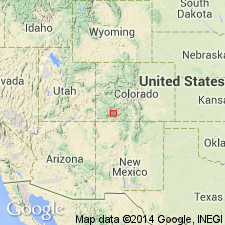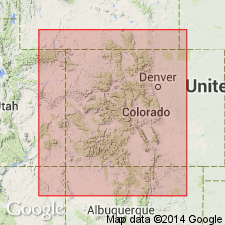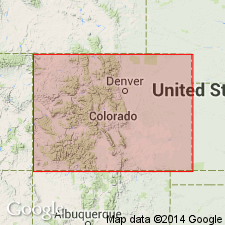
- Usage in publication:
-
- Electra Lake Gabbro*
- Modifications:
-
- Named
- Geochronologic dating
- Dominant lithology:
-
- Gabbro
- Granodiorite
- AAPG geologic province:
-
- Southern Rocky Mountain region
Summary:
Name assigned to a mass of gabbroic and related rocks that intruded the Twilight Gneiss and Irving Formation at the northern half of Electra Lake. Extends southeast to Animas River, Needle Mountains, La Plata Co, CO in the Southern Rocky Mountain region. Type locality is on east shore of north half of lake. Is triangular in plan, about 2 1/2 mi along its southern, east-trending base and about 2 1/2 mi along its western, north-trending side. Paleozoic rocks overlie it to west; its extent in that direction is unknown. Dikes of pink and red alaskite and granophyre, quartzo-feldspathic pegmatite and hornblende-bearing pegmatite cut the gabbroic rocks. Is markedly heterogeneous. Range of rock types extend from olivine gabbro to biotite-augite granodiorite. Gabbro with augite and median or sodic labradorite as major constituents, and with minor hornblende, biotite, ilmenite, and magnetite, is the most abundant variety. The rocks are massive, medium to coarse grained of brown to dark gray. Rb-Sr whole rock isochron of 1,454 +/-50 m.y. reported on the gabbro. A U-Pb age of 1,460 +/-20 m.y. reported on the alaskite and granophyre in a dike. Geologic sketch map. Shown as equivalent in age to Eolus Granite, younger than the quartz diorite of Pine River, and older than Trimble Granite on map explanation.
Source: GNU records (USGS DDS-6; Denver GNULEX).

- Usage in publication:
-
- Electra Lake Gabbro*
- Modifications:
-
- Overview
- AAPG geologic province:
-
- Southern Rocky Mountain region
Summary:
Occurs in a pluton about 6 sq mi (16 sq km) in area in Needle Mountains. Listed with granitic rocks and gabbro of circa 1,400 m.y. (Precambrian Y) age group.
Source: GNU records (USGS DDS-6; Denver GNULEX).

- Usage in publication:
-
- Electra Lake Gabbro*
- Modifications:
-
- Overview
- Areal extent
- AAPG geologic province:
-
- Southern Rocky Mountain region
Summary:
Is one of ten formally named lithodemic units of the Middle Proterozoic Berthoud Plutonic Suite (a new name) in the Southern Rocky Mountain region. Known only in one pluton exposed in a 16 km sq (6 mi sq) at west edge of Needle Mountains about 35 km north of Durango. Is a dark, massive, and predominantly coarse-grained inhomogeneous unit containing facies ranging from olivine gabbro to biotite-augite granodiorite. Has a whole rock Rb-Sr isochron age of 1,425 +/-50 m.y.
Source: GNU records (USGS DDS-6; Denver GNULEX).
For more information, please contact Nancy Stamm, Geologic Names Committee Secretary.
Asterisk (*) indicates published by U.S. Geological Survey authors.
"No current usage" (†) implies that a name has been abandoned or has fallen into disuse. Former usage and, if known, replacement name given in parentheses ( ).
Slash (/) indicates name conflicts with nomenclatural guidelines (CSN, 1933; ACSN, 1961, 1970; NACSN, 1983, 2005, 2021). May be explained within brackets ([ ]).

